If you receive an INACCESSIBLE_BOOT_DEVICE error after you have upgraded to Windows 11/10, or after you used Reset your Windows 11/10 PC, then this post suggests some fixes to overcome this issue.
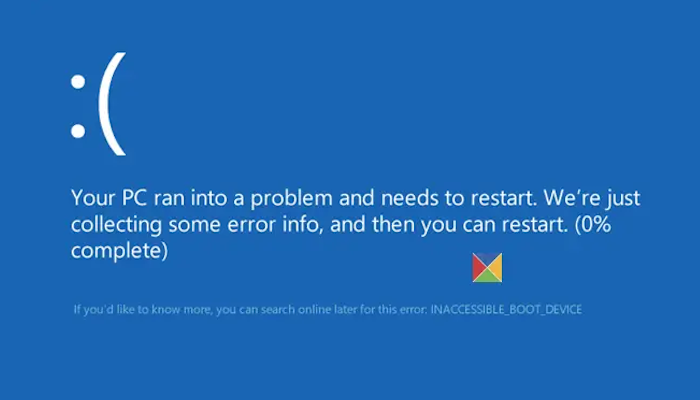
The INACCESSIBLE BOOT DEVICE bug check usually indicates that the Windows operating system has lost access to the system partition during startup. If this happens, the system usually shuts itself down after showing a Blue Screen or Stop Error to protect itself from probable data corruption or loss.
Fix INACCESSIBLE_BOOT_DEVICE Blue Screen
There can be multiple reasons for the Inaccessible_Boot_Device Stop error.
- Missing, corrupted, or misbehaving filter drivers that are related to the storage stack
- File system corruption
- Changes to the storage controller mode or settings in the BIOS
- Using a different storage controller over the default driver from Windows
- Moving the hard disk to a different computer that has a separate controller
- A faulty motherboard or storage controller, or faulty hardware
- Failure of the TrustedInstaller service to commit newly installed updates because of Component-Based Store corruption
- Corrupted files in the Boot partition
Here are a few suggestions you can try to resolve the issue. See what applies in your case:
- If you think a boot device may be at fault, you may need to edit the boot options.
- Remove any recently added hardware.
- Check if the disk firmware version is incompatible with Windows 11/10. If not, you may need to update to the latest firmware version. See if you need to update the BIOS.
- If you recently added a driver, restart your computer, enter the Advanced Boot Options menu, and select the Last Known Good Configuration option. You may boot Windows into Safe Mode and try a system restore or a Rollback.
- If you think the cause could be hard disk corruption, Run Chkdsk /f /r on the system partition. If you cannot boot into Windows, use the Recovery Console and run Chkdsk /r or run Chkdsk from the Repair Console.
- If you just upgraded to Windows 11/10 and then you see this error, then, download and use Media Creation Tool, using another computer and save it to a USB device. Use it to perform a clean install, by clicking on the setup file or booting from the USB. If you are asked for a product key, click on Skip this step. Windows will activate itself when you sign in with your Microsoft account.
Read: UNMOUNTABLE_BOOT_VOLUME Blue Screen Error
Advanced troubleshooting for Stop error 7B or Inaccessible_Boot_Device error in Windows 11/10
Use the following fixes to resolve the INACCESSIBLE BOOT DEVICE error in Windows 11/10.
- Check the hard disk connections
- Verify that the boot disk is accessible
- Verify the integrity of the Boot Configuration Database
- Reset BIOS to the default
- Toggle the VMD Controller setting (if applicable)
Let’s see all these fixes in detail.
1] Check the hard disk connections
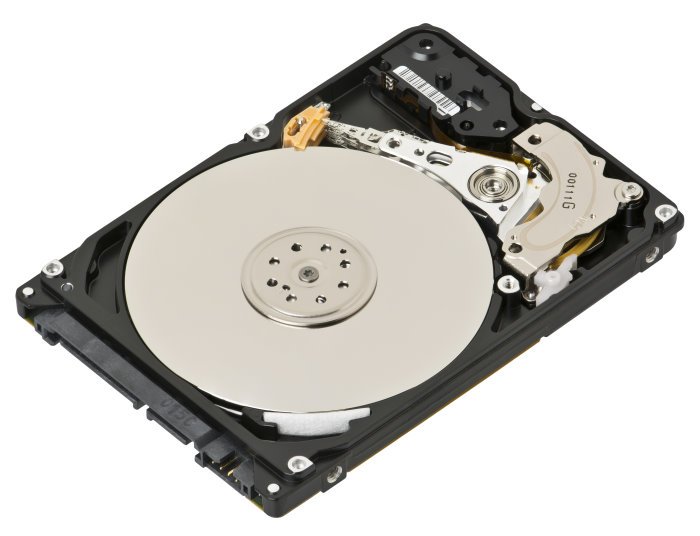
Your computer might not be able to access the boot drive due to the loose cable connections. Check this. Turn off your computer completely and then open the computer case. Now, check all the cables connected to your hard drive. If the cable connections are loose, disconnect the cables and connect them properly. Now, turn on your computer and see if the error occurs.
2] Verify that the boot disk is accessible
Boot into Advanced Recovery, and then open Command Prompt. Here we will figure out if the boot disk is connected and available.
Microsoft recommends that you execute diskpart, and then run list disk command. This command will reveal the list of physical drives that are attached to the computer. If they are connected, you should receive details just like the image below:

Note:
- UEFI interface will have an asterisk () in the **GPT* column.
- BIOS interface will not have an asterisk in the Dyn column.
If the list disk command lists the OS disks correctly, run the list vol command in diskpart. It should generate an output similar to the next image.

The image above displays Volume 1 as the boot disk. If there is no similar listing, you may have to either repair the boot partition on your own or connect with the service center of the OEM.
3] Verify the integrity of the Boot Configuration Database
Boot Configuration Database, a replacement of Boot.ini file, contains boot configuration parameters and controls how the operating system is booted. If there is any corruption or misconfiguration, we will have to fix it. Before that, let’s diagnose if there is a problem.
Boot into Advanced Recovery, and then open Command Prompt. Type bcdedit and hit Enter. You should results like in the image below. UEFI and BIOS have their slight differences.
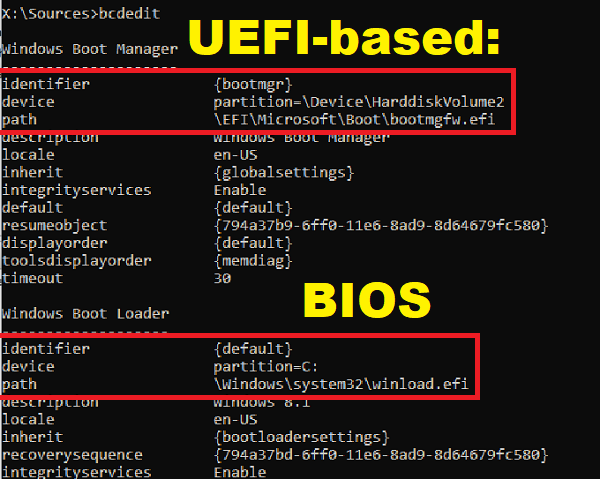
In the results, notice if the identifier is set to default, and the device & path, point to the correct partition. It can only ensure that the “winload” file loads correctly. If this is not what you see, we will have to fix BCD.
The BIOS interface will not have any path, but the drive. But the UEFI interface will show a complete path in the device partition parameter.
a] Set default device partition
- Take the backup of BCD using the command bcdedit /export C:\temp\bcdbackup. To restore at a later stage, you can replace /export with /import.
- If the device under {default} is wrong or missing, run the bcedit command with the set option bcdedit /set {default} device partition=C:
b] Re-create the BCD completely
If you receive an error message that says The boot configuration data store could not be opened, The system could not find the file specified, then execute bootrec /rebuildbcd on the Command Prompt.
c] Verify Location of winload and bootmgr
Bootmgr(Windows Boot Manager) and Winload (Windows OS Loader) are part of the boot phases. PreBoot loads Boot manager, which in turn loads Winload. If the files are not in their correct places, the boot process will be stuck. Here are the locations of the files-
- bootmgr: %SystemDrive%\bootmgr
- winload: %SystemRoot%\system32\winload.exe
Before going ahead, make sure to make a backup of all the contents under the SYSTEM partition to another location. It will come in handy if something goes wrong. Use the Command Prompt to navigate to the System drive, and create a folder where you can back up everything.
Navigate to these directories, and unhide files using Attrib -s -h -r command. If they are not in their place, let’s rebuild it.
Bcdboot <**OSDrive* >:\windows /s <**SYSTEMdrive* >: /f ALL
Where “OSDrive” is where Windows is available, and the system drive is where the bootmgr resides.
Reboot and see if this has helped.
4] Reset BIOS to the default
One easy way to fix this error is to reset your computer BIOS to the default. Enter your computer BIOS and find the setting to reset it. Alternatively, you can remove the CMOS battery and reinsert it. This action will also reset BIOS to the default.
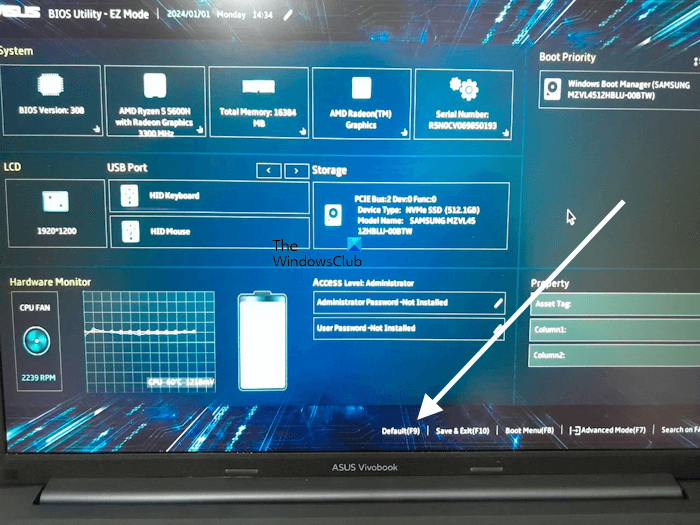
Resetting the BIOS to the default will fix the problem if the error occurs due to the incorrect boot order.
5] Toggle the VMD Controller setting (if applicable)
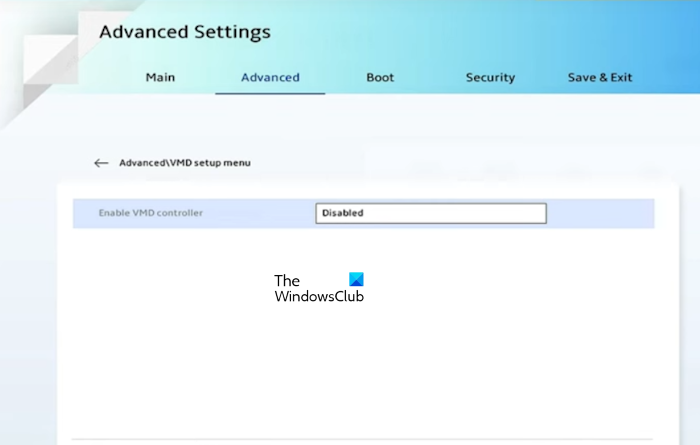
You can also try to toggle the VMD Controller setting in your system BIOS and see if it helps. If the VMD Controller setting is enabled, disable it. If the setting is disabled, enable it. You need to refer to the official website of your computer manufacturer to know whether this feature is available on your system or not.
If nothing works, perform a clean installation of Windows. However, this action will wipe out all the data.
How do I fix the Windows 11 boot error?
It depends on the boot error you receive on starting your computer. The methods to troubleshoot and fix the boot error on Windows 11 depend on the error occurring. You can note down the error code and search for its possible solutions on the internet on another working computer. Boot issues occur due to both hardware and software problems. For example, boot issues after upgrading or installing a new SSD, after enabling the Secure Boot, after a power outage, etc. In each case, the ways to fix this error are different.
How to remove a CMOS battery?
A CMOS battery is a small coin-shaped battery. Its function is to provide a continuous power supply to the BIOS chip, so all the BIOS settings remain saved after shutting down the computer and turning off the power external supply. Removing a CMOS battery resets the BIOS settings to the default values. To remove a CMOS battery, you can use a screwdriver. Open your computer case and locate the battery. Gently pull it out with the help of the screwdriver.
TIP: This post will help you if you receive a Blue Screen after Windows Updates.
my starting page in win10 says administrator and then Your account has been disabled . Please see system administrator. What can I do to restore this account? I am the system administrator myself. Thanks.
After I upgraded from Win7. It will not allow me to get to the actual starting page. What can I do?
Can you see if you can boot in Safe Mode? https://www.thewindowsclub.com/boot-windows-10-in-safe-mode
I cannot. All a get at rebooting is a page that says – (blank) administrator – your account has been disabled. See you account administrator.I got no means to reboot it
enyone know this error and a solution?: ”unknown nt operatingsystem code 10 detekted”, on startup and opening system apps.
no. I’m blocked from moving further.
I had this same Inaccessible Boot Device come up when I was upgrading to Windows 10. I tried running the iso disc over the existing upgrade and putting the key in at the beginning. I saw at about 60% a message come on the screen saying my hard drive was being repaired. Somehow it worked and I have Windows 10 now. I read some of the other posts and had doubts I could get this upgrade to work. I am very happy right now. I hope this helps somebody else out even though people have tried this and it did not work. It worked for me.
Was doing a system restore after windows 10 was running due to other issues. It is now in a cycle of blue screen-restart-blue screen-restart. I can’t do anything suggested since in can’t get a startup screen or home screen.
same
Had the same problem on my toshiba laptop. I fixed it by turning off computer, holding down the zero key then turning the laptop back on, all the time holding the zero key down. Keep holding down until you get a white bar accross the bottom, and it beeps. will reinstall your system back to out of box conditon. Huope this works on your computers.
I had this problem and all i did was unplug my Hard Drives and plug them back in worked for me! Moved around some BIOS setting also for boot options!
Hey guys, i have this issue after rolling back, its error 0x000007b
INACCESSIBLE_BOOT_DEVICE
Is there a way i can do this without loosing files or programs, i dont need the pain of going through it all.
I have a notebook it is doing the same what should I do? I can’t get in at all
I recently upgraded to windows 10. I had just tried to reset my computer and it came up with this Same message. How can it be fixed?
I recently upgraded to windows 10 from 7, and I did not like it so I tried to factory reset. However, now I just get the message inacessable_boot_device. I have the windows 7 reinstall disc but cant get into the bios as my keybpard does not work until I am at the desktop, what can I do and how do I fix this?
My computer is in a loop. There is no way I can install or clean anything!
After trying to reset my pc it’s giving the” your computer had a problem and needs to reset,we will do it for you” with the, inaccessible_boot_device And that’s all it does and repeats the cycle. How do I fix this without getting online for the download app. That fixes it?
how can you do any of these things when the computer wont start up
Same problem here. And it starts over and over again. I have no buttons to click at. How do I get out of this and get my computer back?
Windows 10 erased your factory reset, I had to replace the hardrive and uninstall Windows 10 and reinstall the factory Windows 7. Good luck
Å….sliter du med PC-en Frode? Dette er ingen stor sak. Kan av og til være verre å fikse det hvis du har masse data du gjerne vil redde, men hvis du har tatt “backup” av alt og hadde tenkte å resette helt (til fabrikinnstillinger) er det bare en bagatell…
Maybe you could boot in Safe Mode and/or use the Advanced startup options/Recovery Console to get in.
I just had t
I just had this problem and i did was:
1. Take out the battery. (Laptops)
2. Start a safe mode
3.Restart computer
It works, i am now using my laptop, but without a battery.
I will be very upset if i log in and it does not activate itself. My hardrive was rendered completely useless after the reinstall so so im now clean installing from a usb dont have the money to buy another copy of windows i baught it allready jnstalled o i dont have a cd key
I had lost my OS during upgrade to from Windows 7 to WIndows10. When I boot the desktop, the message “there is no OS, Press CTR-ALT-DEL”. I had purchased a Windows10 to to start a fresh installation. During set-up I chose under HP partition. The following errors occur:
1st installation – error code 0xc000001
2nd attempt – inaccessible boot device
anyone has any idea what’s going on?
Hi! I need your help please ! Ok so i downloaded window 10 on my pc ( window 7) . Everything went ok until my sister accidently close my laptop during the process , when i turn my laptop back on , it went to the blue screen ( u have ran into a problem) it kept restarting ! When the screen pop uo again there was no button or anything i restore to . So i went on youtube and i followed their instructions : I use my 4gb drive on my other pc (window 8) to download window 10 . After i download it, i went back on other pc ( window 7 ) that had a blue screen ! I use my flash drive , so i can restore it but nothing happen! What should i do!
run the system utilities hit key according to your brand like as a for dell press f2 to run system setup and check your boot sequence.. all problems solved … if u have any problem you can whatsapp me at this no. 03084451636 … thanks..
What happens if it never restarts? I just bought this computer today
right click on the cmd icon, another right click on cmd voice and then execute as administrator
Windows 10 is ridiculous – Last known Good Configuration was a must have – (for boot issues after unstable hardware causes a crash) and once in a while was the very quick fix. Who the hell thought it was a good idea to remove this must have tool.. I guess the people that want me to charge for 3 hours to unnecessarily restore a system rather than 15 minutes for a simple repair. Microsoft Idiots..!!! (Linux anyone?)
from redmond with love… windows (horrible as always)
Hello. I created a copy of my internal disk (with boot capacity – windows 10) to an external USB disk. Then I change the bios for the computar starts with the USB device. I made it twice and appears the same error “INACCESSIBLE BOOT DEVICE” and I can’t start the computer with the usb disk. I want it for security porposes. Can you help me I don’t know what do more. More: I have already created a pen usb with windows for a cleaning instalation and all works fine. Why can’t I start the system with the external disk?
I just did a clean install of Windows 10 Pro from an OEM disk on a new system two days ago. I was installing other drivers after it came up. One driver wanted me to reboot, so OK. The system came up but I got a notification that Windows update was unable to finish installing updates. The heck with that, I said. Windows is always installing updates. Eventually, I had to reboot for again as I was still installing things. This time it came up with the inaccessible boot device error. Safe mode wouldn’t work, and the command line tool showed me that the C drive was now just the system reserved partition and no other disk was present but my data drive. Fortunately, the partition was not lost. just not mounted. I ran refresh (keeping my files) from the DVD and got the system back up. This time, I explicitly ran Windows update. At first it told me I had NO updates, then a little later I had tons of updates. It took a while, but I let it all run to completion before i did anything else. THEN, I installed the rest of the software and now have no problems.
Two takeaways: When Windows Update says “don’t turn off your computer” he really means it. Don’t install other software which might require a reboot unless you know Windows Update is not active. Second, turn off automatic Windows Update because he works in secret and may butt heads with something else you are doing. Run it manually once a week or something, and don’t restart until it wants you to.
I encountered this last a week or two ago. i had fixed it by bootrec /fixboot with the windows 10 disc.
I did the chkdsk then I said to do it again with /f so I did and now it says that it cant do it as the disk is write protected
I know this is an old thread
Same problem here. Have you had any luck since?
I did a reset after getting that message because it was the only thing that could get the computer to start. Once I got it started again, several things were missing, including the internet browsers (Google Chrome and Internet Explorer).
I clicked on the new browser that replaced IE (Microsoft Edge). It opened very briefly then quickly closed. I clicked on the Store link to find another browser to download and it said there was no internet connection even though when I checked the internet connection it was connected to the same network.
The reset was probably a bad idea with unintended consequences. First, what should I have done instead?
Second, how can we restore internet access?
Note: when we called Windows tech support, after unsuccessfully trying several fixes, he had me unplug the cable that runs from the computer to the modem (a cable modem (comcast). Now we’ve lost our phone service too.
hi Arthar Khan cant get through to u.
no help – “Inaccessible boot device” says it all. I can see them, I can select them, but can’t boot from any of them. DVD doesn’t show up. Unlike others, my mouse and keyboard work. NO OPTIONS to restore rollback or ANYTHING works in any of the 3 blue screens I can see on occation. I created two media store win10 devices on USB, tried a backup on edxternal hard drive. They all go back to booting and the pick keyboard layout. (can’t access boot device). “I HATE WINDOWS”. ONly machine I have no problems with runs OSX. To bad I have 8 f’ing PC’s and only one Mac.
SAME HERE – last night said Updating don’t turn the computer off. I didn’t – I went to bed. This morning it has this problem. I’ve been running this machine and win10 for 8 mo. New Alienware A51, This is B.S. Microsoft. OSX doesn’t have this crap happen. I can’t even boot from original DVD. I can’t boot from USB (I have the choices… but it won’t boot!) I thought it was a virus it’s so bad. I’m a 30+ year computer geek guru and so far no way out of this. I’m going in side and mesisng with my 4 HD’s to see if I can find a work around. WINDOWS SUCKS No damn wonder it was free.
If you had gotten the error, then attempted to perform a factory reset like I had and still been stuck on error blue screen and system repair THE ONLY FIX I FINALLY FOUND was to unplug the hard drive and plug it back in. I did so then when I got back on it still went to system repair. I then attempted to go into safe mode when a Windows error popped up and said it would need to instal Windows before accessing safe mode or something of the such. I then hit enter for okay. The computer went back to the loading screen and stayed there for a good bit. About 30 minutes passed and ta dah it brought up the computer setup screen as if it was brand new. Have had no problems since and runs great. Hope this help I understand the frustration because I couldn’t find a fix for 3 weeks solid. Goodluck!
I keep having issues with a flash drive/thumb drive. The drivers for the thumb drive will stop working and when restarting the computer to reinstall drivers, it will show me the inaccessible error. From there I can only do a system restore which takes forever but gets everything working again. After a short time I get the same issue on my flash drive and have to repeat every time I use it. I have used multiple thumb drives it happens repeatedly regardless. Any ideas?
damn u really dont like windows too much. are you implying that OSX is a better os just because its so streamlined that there’s no errors on startup? this is obviously an issue but there’s no reason to be so angry. i dont believe that you’re a 30+ year “geek guru”. anyone that would call themselves a “geek guru” obviously doesn’t have that much experience.
So many of these “help” pages assume you can get to Windows, or the Advanced Startup Options, or even a C: prompt. I’m stuck in a reboot loop after a driver upgrade failed (several were in the queue, so i’m not sure which one crashed). I can’t get to Safe Mode, and System Recovery failed (twice), even though I’d recently confirmed several good recovery points. I’d rather not reinstall Windows if not absolutely necessary. Any other ideas?
Pls see https://www.thewindowsclub.com/windows-10-stuck-in-endless-reboot-loop and https://www.thewindowsclub.com/windows-10-stuck-screen-restarting-will-not-boot